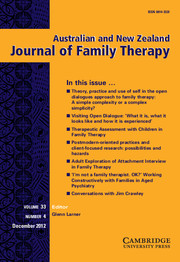Crossref Citations
This article has been cited by the following publications. This list is generated based on data provided by
Crossref.
Shochet, Ian M.
Smyth, Tanya
and
Homel, Ross
2007.
The Impact of Parental Attachment on Adolescent Perception of the School Environment and School Connectedness.
Australian and New Zealand Journal of Family Therapy,
Vol. 28,
Issue. 2,
p.
109.
Carr, Alan
2008.
Feedback for ANZJFT.
Australian and New Zealand Journal of Family Therapy,
Vol. 29,
Issue. 4,
p.
234.
Carr, Alan
2008.
Thematic review of family therapy journals in 2007.
Journal of Family Therapy,
Vol. 30,
Issue. 3,
p.
296.
Kozlowska, Kasia
2009.
Attachment Relationships Shape Pain-Signaling Behavior.
The Journal of Pain,
Vol. 10,
Issue. 10,
p.
1020.
Wilson, Samantha L.
2009.
Attending to Relationships.
Topics in Language Disorders,
Vol. 29,
Issue. 1,
p.
18.
Crittenden, Patricia McKinsey
and
Dallos, Rudi
2009.
All in the Family: Integrating Attachment and Family Systems Theories.
Clinical Child Psychology and Psychiatry,
Vol. 14,
Issue. 3,
p.
389.
van den Dries, Linda
Juffer, Femmie
van IJzendoorn, Marinus H.
and
Bakermans-Kranenburg, Marian J.
2009.
Fostering security? A meta-analysis of attachment in adopted children.
Children and Youth Services Review,
Vol. 31,
Issue. 3,
p.
410.
Kozlowska, Kasia
and
Williams, Leanne M.
2009.
Self-protective organization in children with conversion and somatoform disorders.
Journal of Psychosomatic Research,
Vol. 67,
Issue. 3,
p.
223.
Spieker, Susan
and
Mckinsey Crittenden, Patricia
2010.
Comparing two attachment classification methods applied to preschool strange situations.
Clinical Child Psychology and Psychiatry,
Vol. 15,
Issue. 1,
p.
97.
Dignam, Paul
Parry, Peter
and
Berk, Michael
2010.
Detached from attachment: neurobiology and phenomenology have a human face.
Acta Neuropsychiatrica,
Vol. 22,
Issue. 4,
p.
202.
Priddis, Lynn E.
and
Howieson, Noel D.
2010.
Parent–child relationships and quality of children’s episodic recall.
Early Child Development and Care,
Vol. 180,
Issue. 10,
p.
1299.
Farnfield, Steve
Hautamäki, Airi
Nørbech, Peder
and
Sahhar, Nicola
2010.
DMM assessments of attachment and adaptation: Procedures, validity and utility.
Clinical Child Psychology and Psychiatry,
Vol. 15,
Issue. 3,
p.
313.
Stacks, Ann M.
2010.
Self-protective strategies are adaptive and increasingly complex: A beginner’s look at the DMM and ABCD models of attachment.
Clinical Child Psychology and Psychiatry,
Vol. 15,
Issue. 2,
p.
209.
Hautamäki, Airi
Hautamäki, Laura
Neuvonen, Leena
and
Maliniemi-Piispanen, Sinikka
2010.
Transmission of attachment across three generations.
European Journal of Developmental Psychology,
Vol. 7,
Issue. 5,
p.
618.
Shah, Prachi E.
Fonagy, Peter
and
Strathearn, Lane
2010.
Is attachment transmitted across generations? The plot thickens.
Clinical Child Psychology and Psychiatry,
Vol. 15,
Issue. 3,
p.
329.
Crittenden, Patricia
Kozlowska, Kasia
and
Landini, Andrea
2010.
Assessing attachment in school-age children.
Clinical Child Psychology and Psychiatry,
Vol. 15,
Issue. 2,
p.
185.
McKinsey Crittenden, Patricia
and
Poggioli, Daniele
2011.
Post‐Traumatic Syndromes in Childhood and Adolescence.
p.
391.
Farnfield, Steve
and
Essau, Cecilia A.
2011.
Encyclopedia of Child Behavior and Development.
p.
608.
Pérez, Tania
Di Gallo, Alain
Schmeck, Klaus
and
Schmid, Marc
2011.
Zusammenhang zwischen interpersoneller Traumatisierung, auffälligem Bindungsverhalten und psychischer Belastung bei Pflegekindern.
Kindheit und Entwicklung,
Vol. 20,
Issue. 2,
p.
72.
Wilkins, David
2012.
Disorganised attachment indicates child maltreatment: how is this link useful for child protection social workers?.
Journal of Social Work Practice,
Vol. 26,
Issue. 1,
p.
15.


